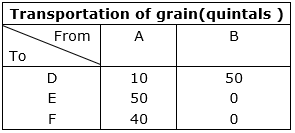Two godowns, A and B, have grain storage capacity of 100 quintals and 50 quintals respectively. They supply to 3 ration shops, D, E and F, whose requirements are 60, 50 and 40 quintals respectively. The cost of transportation per quintal from the godowns to the shops are given in the following table :
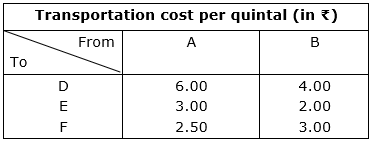
How should the supplies be transported in order that the transportation cost is minimum?
Let godown A supply x and y quintals of grain to shop D and E respectively. Remaining grain storage of A is 100 – x – y. So, now it is supplied to shop F by godown A.
Now, remaining requirement of shop D is 60 – x which is supplied by godown B.
Remaining requirement of shop E is 50 – y which is supplied by godown B.
Remaining requirement of shop F is 40 – (100 – x – y)
= x + y - 60 which is supplied by godown B.
where,
x ≥ 0, y ≥ 0 and 100 – x – y ≥ 0
⇒ x ≥ 0, y ≥ 0 and x + y ≤ 100
60 – x ≥ 0, 50 – y ≥ 0 and x + y – 60 ≥ 0
⇒x ≤ 60, y ≤ 50 and x + y ≥ 60
This can be illustrated by this:
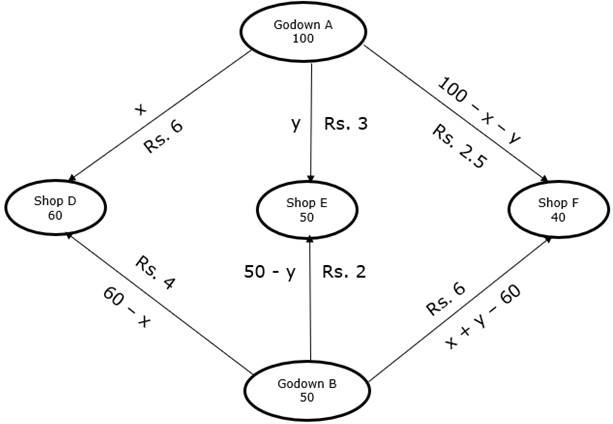
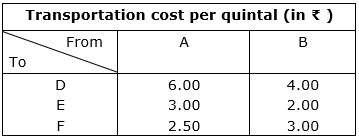
Cost = Number of quintals * Cost of transportation per quintal
Total transportation cost z is given by,
z = 6x + 3y + 2.5(100 – x – y) + 4(60 – x) + 2(50 – y) + 3(x + y – 60)
⇒ z = 6x + 3y + 250 – 2.5x – 2.5y + 240 – 4x + 100 – 2y + 3x + 3y – 180
⇒ z = 2.5x + 1.5y + 410
We need to minimize the cost
Hence, mathematical formulation of LPP is
Minimize z = 2.5x + 1.5y + 410
subject to the constraints,
x + y ≥ 60
y ≤ 50
x ≤ 60
x + y ≤ 100
x, y≥0
The feasible region determined by the system of constraints is as follows:
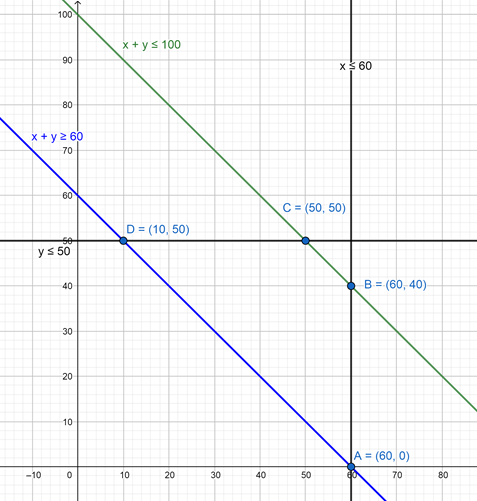
The corner points of enclosed region are A(60, 0) , B(60, 40), C(50, 50) and D(10,50)
The value of z at these corners points is as follows:
Case 1: A(60, 0)
z = 2.5x + 1.5y + 410
⇒ z = 2.5(60) + 1.5(0) + 410
⇒ z = 150 + 0 + 410
⇒ z = 560
Case 2: B(60, 40)
z = 2.5x + 1.5y + 410
⇒ z = 2.5(60) + 1.5(40) + 410
⇒ z = 150 + 60 + 410
⇒ z = 620
Case 3: C(50, 50)
z = 2.5x + 1.5y + 410
⇒ z = 2.5(50) + 1.5(50) + 410
⇒ z = 125 + 75 + 410
⇒ z = 610
Case 4: D(10, 50)
z = 2.5x + 1.5y + 410
⇒ z = 2.5(10) + 1.5(50) + 410
⇒ z = 25 + 75 + 410
⇒ z = 510
The value of z is minimum in fourth case at point D(10, 50)
As, x = 10, y = 50
Godown A supplies to:
Shop D = x = 10 quintals
Shop E = y = 50 quintals
Shop F = 100 – x – y = 100 – 10 – 50 = 40 quintals
Godown B supplies to:
Shop D = 60 – x = 60 – 10 = 50 quintals
Shop E = 50 – y = 50 – 50 = 0 quintals
Shop F = x + y – 60 = 10 + 50 – 60 = 0 quintals
Minimum cost for transportation of these quintals to their respective shops = Rs. 510
